HOME
PLANTS
Leaf
A leaf is the part of a plant
that serves primarily as the plant's food-making organ. Leaves have
other functions, as well, which remove excess water from the plant
and obtain oxygen and energy. Leaves also may store food and water
and provide structural support.
A leaf is an extension of a
plant's stem. Although most leaves are flat, broad, or bladelike,
they also may be many other shapes, including round, oval, or
feathery. In general, the leaves of trees such as hardwoods tend to
be broad and relatively large, and the leaves of conifers, or
cone-bearing trees, are usually small and needlelike in shape. In
size, leaves range from only several millimeters (a fraction of an
inch) long, as in the water plant Elodea, to 15 to 18 m (15 to 60 ft)
long, as in some palm trees.
 Colorful
Autumn Leaves - Brilliant autumn colors, characteristic of the
leaves of many plants, are due to the presence of accessory leaf
pigments that normally assist the plant in photosynthesis by
capturing specific wavelengths of sunlight. These pigments, called
carotenoids, become visible when the leaf dies in the fall.
Colorful
Autumn Leaves - Brilliant autumn colors, characteristic of the
leaves of many plants, are due to the presence of accessory leaf
pigments that normally assist the plant in photosynthesis by
capturing specific wavelengths of sunlight. These pigments, called
carotenoids, become visible when the leaf dies in the fall.
Green leaves derive their
color from chlorophyll. The presence of additional pigments causes
other leaf colors such as red in coleus and purple in cabbage. In
temperate regions of the world, the leaves of some plants change
color in autumn. Leaves of most garden plants turn yellow in the
autumn, but those of many trees take on brilliant orange or red colors.
Most plants whose leaves
change color also lose their leaves in the autumn. Such plants are
called deciduous. In other plants, such as laurels and pines, the
leaves do not change color and do not fall off in autumn. Such plants
are called evergreens.
THE PARTS OF A TYPICAL LEAF
The petiole is a
stalklike structure that supports the leaf blade on the stem. It also
serves as a passageway between the stem and the blade for water and
nutrients and to move the leaf into the best position for receiving
sunlight. Most petioles are long, narrow, and cylindrical. Many
plants, such as grasses and corn, do not have petioles. In these
plants the base of the blade is attached directly to the stem—the
base encircles the stem as a sheath.
The leaf blade is
usually a thin, flat structure. Its edges may be smooth, jagged or
lobed. The surface of the blade may be smooth, fuzzy, sticky, dull,
or shiny. In most plants the leaves have a single blade and are
referred to as simple. In other plants, such as clover, the blade is
divided into separate leaflets. This kind of leaf is called a
compound leaf. Most of the functions carried on by leaves take place
in the blade.
Epidermis
The blade consists of an
upper and lower skin, or epidermis, and a spongy layer of tissue with
a branching system of veins.
The epidermis is a thin,
usually transparent, colorless layer of cells that covers both the
upper and lower surfaces of the blade. The epidermis prevents the
leaf from losing excessive amounts of water and protects it against injury.
In most plants the epidermis
is covered with a waxy substance secreted by the epidermal cells
responsible for their glossy appearance and gives the leaf additional
protection by slowing down the rate at which water is lost.
In many kinds of leaves,
hairs grow from the epidermis. The soft hairs give the leaves a
woolly texture. In some plants the epidermal hairs secrete fluids.
The strong-smelling oils of the peppermint and spearmint plants come
from epidermal hairs. In other plants, such as the nettle, the
epidermal hairs are stiff and contain a poisonous fluid that produces
a skin irritation when a person is pricked by them.
Guard Cells
Scattered throughout the
epidermis are pairs of bean-shaped cells, called guard cells. Guard
cells contain chloroplasts which enable leaves to carry on
photosynthesis because they are able to absorb carbon dioxide and
sunlight, which are required for the food-making process. In response
to heat and light, each pair of guard cells pulls apart, and a tiny
pore forms between them. The pores, called stomata, open to the
outside atmosphere.
When the stomata are open,
carbon dioxide and oxygen pass either in or out—when carbon
dioxide enters, it takes part in photosynthesis, the food-making
process that releases oxygen as a waste product. This oxygen passes
out of the leaf. At the same time, oxygen also enters the leaf, where
it takes part in respiration, a process that forms carbon dioxide as
a waste product. This carbon dioxide passes out through the stomata.
Water also passes out of the open stomata in the form of a vapor.
Generally, there are more stomata on the under surface of a leaf than
on the upper surface. This prevents water from evaporating too
quickly or in excessive amounts from the leaf's upper side, which is
exposed to the sun. Stomata close at night, providing another level
of water conservation.
Water Pores
In addition to the stomata,
many kinds of leaves have large specialized water pores in their
epidermis. These pores allow a plant to lose liquid water and remain
open all the time.
Mesophyll
The mesophyll, the spongy
layer sandwiched between the upper and lower epidermis, consists of
many thin-walled cells that are usually arranged in two layers. The
palisade layer is next to the upper epidermis. It consists of
cylindrical cells that are packed closely together. Next to the
palisade layer and making up most of the thickness of the leaf blade
is the spongy layer. The spongy layer consists of roundish cells that
are packed loosely together and have numerous air spaces between
them. In most plants the spongy layer extends down to the lower
epidermis. However, in certain grasses, irises, and other plants
whose leaves grow straight up and down, the spongy layer is wedged
between two palisade layers of mesophyll. Like the guard cells, all
the cells of the mesophyll contain chloroplasts.
Veins
Running through the middle of
the mesophyll and branching out to all of its cells are veins. The
veins extend into the petiole and connect with other veins in the
stem of the plant. A major function of the veins is to help support
the leaf blade. Each type of plant has a characteristic pattern of
veins forming lines and ridges in the blade.
The veins of a leaf are made
up of two specialized tissues, xylem and phloem. Xylem usually forms
the upper half of the vein. It consists of tubular open-ended cells
that are arranged end to end. The walls of the cells are thick and
rigid. Xylem conducts water and dissolved minerals to the leaf blade
from the rest of the plant.
Phloem lies on the underside
of the vein. It is made up of thin-walled tubular cells with tiny
openings at their ends, somewhat like a sieve. These cells are also
arranged end to end. Phloem carries food manufactured in the blade to
the rest of the plant.
LEAF GROWTH AND LEAF FALL
A leaf has a limited life
span, usually living for only a single growing season in most
deciduous plants and seldom more than a few years in evergreen
plants. In temperate regions, leaves develop and grow during spring
and early summer. In autumn they grow old, change color, and die. In
nonwoody plants (low in xylem) the leaves wither and fall away
because of decay and various external conditions. Woody plants (rich
in xylem) lose their leaves as a result of characteristic changes in
the base of the leaf. In tropical regions that have distinct wet and
dry seasons, the formation and fall of leaves depend on moisture
conditions rather than temperature. Contrary to popular belief,
evergreen plants also shed their leaves. However, evergreens are
never bare because the old leaves are pushed out only as new leaves develop.
Budding
All leaves develop from buds,
which are located at the nodes, or joints, of a plant stem and at the
end of a plant stem. Contained in the buds are areas of rapidly
growing tissue, called the meristem. The meristem gives rise to the
first recognizable signs of the leaf. In the spring the buds shed
their outer covering and open, exposing the leaves.
As leaves develop, they are
arranged on the stem in one of three ways: alternate, opposite, or
whorled. The arrangement provides an equal distribution of leaf
weight on the stem. It also prevents overlapping so that each leaf
can receive adequate sunlight.
Color Changes
In addition to chlorophyll,
leaf cells also may contain other pigments. These pigments account
for the color of autumn leaves. Among the pigments found in leaves
are yellow xanthophylls, yellowish-orange carotenes, and red and
purple anthocyanins. Leaves also may contain tannins, which give them
a golden-yellow color in autumn.
Like chlorophyll,
xanthophylls and carotenes are contained in tiny granules in some
leaf cells. Although these pigments are present throughout the leaf's
lifetime, their colors are usually masked by the green of
chlorophyll. In the autumn, however, chlorophyll production
decreases, and the yellow and orange pigments become visible in the
leaves. Eventually all pigment production stops, and the leaves turn brown.
Unlike xanthophylls and
carotenes, anthocyanins are not contained in granules but are
dissolved in the liquid part of leaf cells. In some plants, such as
coleus and red cabbage, anthocyanins are always present, giving the
leaves a reddish or purplish color. In other plants, anthocyanins are
not present throughout the life of the leaf, but are produced only
under certain conditions. In oak and maple leaves, for example, sugar
accumulates in autumn. This accumulation is believed to result in the
formation of anthocyanins and the production of vivid colors in the leaves.
Leaf Fall
The leaves of evergreens
continue to function and manufacture food throughout the year. In
deciduous plants, however, the leaves stop functioning in the autumn
and drop off. Leaves may be killed by frost, but changes due to age
and growing conditions occur well before then. Decreased day length,
reduced light intensity, lower temperatures, lack of water, and
decrease of growth-promoting substances in the plant all contribute
to the decline of the leaves. The changes start in the weakest part
of the petiole, at the base. During autumn the cells in the base of
the petiole begin to disintegrate and die. As a result, the leaf
blade is supported only by the veins in the petiole. Soon the
vascular bundles become plugged, decreasing the flow of water, food,
and minerals to and from the leaf blade. When the blade is disturbed,
as by wind, it breaks off the plant at the base of the petiole.
VARIOUS TYPES OF LEAF
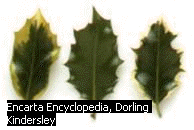
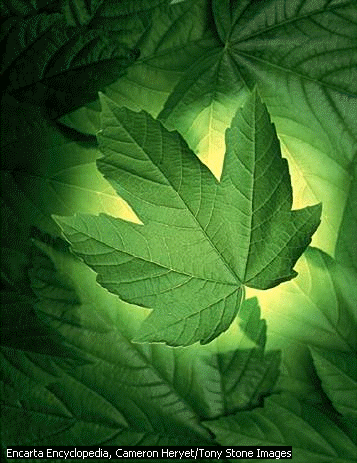 Varigated
Leaf - The green color in a normal holly leaf (left) results from the
uniform distribution of the green pigment chlorophyll. In a
variegated leaf this important photosynthesizing pigment is reduced
or lacking altogether in certain parts of the leaf, as indicated by
the yellow color. Though the holly plant mounts a spiny defense
against leaf-eating animals, its variegated leaves generally will not
survive in nature due to this pigment deficiency.
Varigated
Leaf - The green color in a normal holly leaf (left) results from the
uniform distribution of the green pigment chlorophyll. In a
variegated leaf this important photosynthesizing pigment is reduced
or lacking altogether in certain parts of the leaf, as indicated by
the yellow color. Though the holly plant mounts a spiny defense
against leaf-eating animals, its variegated leaves generally will not
survive in nature due to this pigment deficiency.
Simple
Leaf - this example from a maple tree (right), has a single leaf
blade. The netlike pattern of veins visible here is characteristic of
dicotyledonous plants.
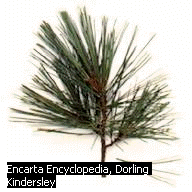 Pine
Needles - The arolla pine (left) has needles that grow in
bundles of five. Pine needles are actually highly modified leaves
that are not shed each year and can remain on the tree for long
periods. Each needle has a tough outer layer called the cuticle,
which in turn has a waxy coating that helps prevent water loss.
Pine
Needles - The arolla pine (left) has needles that grow in
bundles of five. Pine needles are actually highly modified leaves
that are not shed each year and can remain on the tree for long
periods. Each needle has a tough outer layer called the cuticle,
which in turn has a waxy coating that helps prevent water loss.

Succulents
- (right) The thick fleshy leaves of succulent plants swell in damp
conditions to store fresh water. Adaptations such as the white
coloration and waxy, water-sealing coating of some leaves reduce
evaporation. The leaves wrinkle as water is used.
Evergreen
Leaves - The rhododendron is an evergreen (left) —that is, it
does not replace all of its leaves each year. In order to survive the
effects of wind, rain, sun, and insect predation, the leaves of the
rhododendron have a tough, waxy upper surface. They also sometimes
have 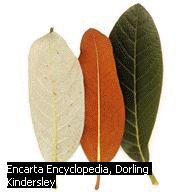 a
feltlike lower surface to help retain water and repel insects.
a
feltlike lower surface to help retain water and repel insects.
 Compound
Leaf - (right) Compound leaves, although they appear to be a
collection of many leaves, arise from a single bud. The leaflets fall
as a group in the autumn. The leaf pictured here is from a
Hercules’ club. It is pinnately compound (with paired, equally
sized leaflets arising from a central blade), and doubly so, with
leaflets attached to matching side stalks. The leaflets of palmately
compound leaves, such as those of the horse chestnut family, radiate
from a single point.
Compound
Leaf - (right) Compound leaves, although they appear to be a
collection of many leaves, arise from a single bud. The leaflets fall
as a group in the autumn. The leaf pictured here is from a
Hercules’ club. It is pinnately compound (with paired, equally
sized leaflets arising from a central blade), and doubly so, with
leaflets attached to matching side stalks. The leaflets of palmately
compound leaves, such as those of the horse chestnut family, radiate
from a single point.
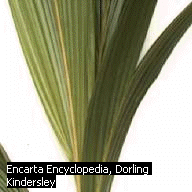
Monocot
Leaf -Leaves of monocotyledonous plants, such as the palm pictured
left, usually have parallel leaf veins. Dicots show netlike venation.
Palm leaves, native to windy environments with little rainfall, have
tough leaves that resist drying out.
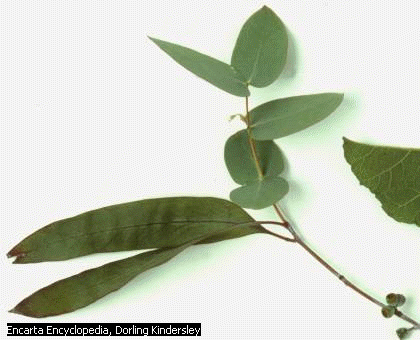
Dimorphic
Leaves - The eucalyptus tree (right)has two totally different shapes
of leaves on the same stem. The young leaves are small, circular, and
completely encircle the branch, while older leaves are long,
bladelike, and borne at the ends of short stalks.
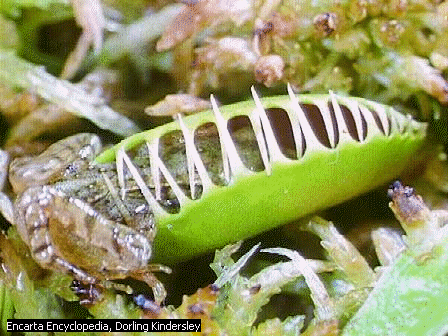 Carnivorous
Leaf - The two lobes of a Venus’s-flytrap leaf form a
deceptively safe and attractive landing place for insects and other
animals. Less than a second after the frog trips the trigger bristles
on the inside surface of the leaf, the lobes close enough to trap the
intruder below interlocking spines. If sensory organs determine that
the prisoner contains protein, the leaf closes further and the
plant’s digestive enzymes start to flow.
Carnivorous
Leaf - The two lobes of a Venus’s-flytrap leaf form a
deceptively safe and attractive landing place for insects and other
animals. Less than a second after the frog trips the trigger bristles
on the inside surface of the leaf, the lobes close enough to trap the
intruder below interlocking spines. If sensory organs determine that
the prisoner contains protein, the leaf closes further and the
plant’s digestive enzymes start to flow.
Unlike leaf-bearing plants,
animals cannot manufacture their own food. For this reason, animals
must receive their nourishment, either directly or indirectly, from
leaf-bearing plants. For example, cattle, sheep, and horses eat the
leaves of grasses and other plants. These animals, in turn, are
consumed by various carnivorous animals, including humans. Humans
also eat many kinds of leaves directly, including artichoke, cabbage,
lettuce, and spinach.
In addition to being a source
of food, leaves provide many useful products. For example, the leaves
of tea plants are made into a beverage, and the leaves of thyme,
sage, and parsley are used for seasoning foods. Tobacco leaves may be
smoked or chewed. Drugs are obtained from the leaves of foxglove,
witch hazel, senna, and many other plants. Oils extracted from the
leaves of geranium and citronella plants are used in manufacturing
perfumes and soaps, and oils from mint and wintergreen leaves are
made into flavoring extracts. Tannins, chemical substances used in
preparing leather, are derived from sumac leaves, and dyes are made
from indigo and henna leaves. The leaves of many plants may be used
as fertilizer.
Microsoft ® Encarta ®
Encyclopedia 2002. © 1993-2001 Microsoft Corporation. All rights reserved.
 Colorful
Autumn Leaves - Brilliant autumn colors, characteristic of the
leaves of many plants, are due to the presence of accessory leaf
pigments that normally assist the plant in photosynthesis by
capturing specific wavelengths of sunlight. These pigments, called
carotenoids, become visible when the leaf dies in the fall.
Colorful
Autumn Leaves - Brilliant autumn colors, characteristic of the
leaves of many plants, are due to the presence of accessory leaf
pigments that normally assist the plant in photosynthesis by
capturing specific wavelengths of sunlight. These pigments, called
carotenoids, become visible when the leaf dies in the fall.
 Varigated
Leaf - The green color in a normal holly leaf (left) results from the
uniform distribution of the green pigment chlorophyll. In a
variegated leaf this important photosynthesizing pigment is reduced
or lacking altogether in certain parts of the leaf, as indicated by
the yellow color. Though the holly plant mounts a spiny defense
against leaf-eating animals, its variegated leaves generally will not
survive in nature due to this pigment deficiency.
Varigated
Leaf - The green color in a normal holly leaf (left) results from the
uniform distribution of the green pigment chlorophyll. In a
variegated leaf this important photosynthesizing pigment is reduced
or lacking altogether in certain parts of the leaf, as indicated by
the yellow color. Though the holly plant mounts a spiny defense
against leaf-eating animals, its variegated leaves generally will not
survive in nature due to this pigment deficiency. Pine
Needles - The arolla pine (left) has needles that grow in
bundles of five. Pine needles are actually highly modified leaves
that are not shed each year and can remain on the tree for long
periods. Each needle has a tough outer layer called the cuticle,
which in turn has a waxy coating that helps prevent water loss.
Pine
Needles - The arolla pine (left) has needles that grow in
bundles of five. Pine needles are actually highly modified leaves
that are not shed each year and can remain on the tree for long
periods. Each needle has a tough outer layer called the cuticle,
which in turn has a waxy coating that helps prevent water loss.
 a
feltlike lower surface to help retain water and repel insects.
a
feltlike lower surface to help retain water and repel insects. Compound
Leaf - (right) Compound leaves, although they appear to be a
collection of many leaves, arise from a single bud. The leaflets fall
as a group in the autumn. The leaf pictured here is from a
Hercules’ club. It is pinnately compound (with paired, equally
sized leaflets arising from a central blade), and doubly so, with
leaflets attached to matching side stalks. The leaflets of palmately
compound leaves, such as those of the horse chestnut family, radiate
from a single point.
Compound
Leaf - (right) Compound leaves, although they appear to be a
collection of many leaves, arise from a single bud. The leaflets fall
as a group in the autumn. The leaf pictured here is from a
Hercules’ club. It is pinnately compound (with paired, equally
sized leaflets arising from a central blade), and doubly so, with
leaflets attached to matching side stalks. The leaflets of palmately
compound leaves, such as those of the horse chestnut family, radiate
from a single point.

 Carnivorous
Leaf - The two lobes of a Venus’s-flytrap leaf form a
deceptively safe and attractive landing place for insects and other
animals. Less than a second after the frog trips the trigger bristles
on the inside surface of the leaf, the lobes close enough to trap the
intruder below interlocking spines. If sensory organs determine that
the prisoner contains protein, the leaf closes further and the
plant’s digestive enzymes start to flow.
Carnivorous
Leaf - The two lobes of a Venus’s-flytrap leaf form a
deceptively safe and attractive landing place for insects and other
animals. Less than a second after the frog trips the trigger bristles
on the inside surface of the leaf, the lobes close enough to trap the
intruder below interlocking spines. If sensory organs determine that
the prisoner contains protein, the leaf closes further and the
plant’s digestive enzymes start to flow.